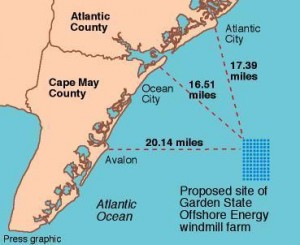Great news from the Jersey Shore. Writing in the Asbury Park Press, David Willis reported Saturday, Oct. 4, 2008 that
New Jersey’s Board of Public Utilities
gave a green light to a Garden State Wind Offshore Energy
, a joint venture between PSEG Renewable Generation and Deepwater Wind, one of several competitors, including BlueWater Wind, Fishermen’s Energy of New Jersey LLC, Occidental Development & Equities LLC, and Environmental Technologies LLC. David Harper of The Press of Atlantic City covered the story Sunday.Street Insider published the Press Release.
“Offshore wind is probably the most cost-efficient and reliable form of energy we can have” said Jeff Tittle, director of the Sierra Club’sNew Jersey Office. “We will have offshore windmills or we will have offshore oil” until the oil runs out and the shore will move as the sea rises and as storms pummel the coasts.
The $1 Billion project will generate 350 megawatts of power, enough for 125,000 homes, and meet approximately 5% of New Jersey’s needs. The $1 Billion cost for the 350 mw facility is $2.86 per watt for construction, compared to $1.87 for the Atlantic City wind farm, and $6.00 per watt, according to Rebecca Smith in the Wall St. Journal for Florida Power & Light’s proposed Turkey Point 3 & 4 nuclear plants.
The wind farm will be generating energy within four years, and be completed by 2013. The first 1 gw wind farm that T. Boone Pickens’ Mesa Power, is building in Texas is forecast to cost $2.00 per watt and be operational by 2011.
New Jersey’s wind farm will be historic. It will be the first offshore wind farm in New Jersey, and with the Delmarva Wind Farm that BlueWater Wind is building off Delaware, and the plant that Deepwater Wind is building off of Rhode Island, one of the first three offshore wind farms, possibly the first in the United States.
While the US will still lag far behind Denmark, Germany, Ireland, Spain, other nations in Europe and the rest of the world, this is a start. I hear the sound of a paradigm shifting.
